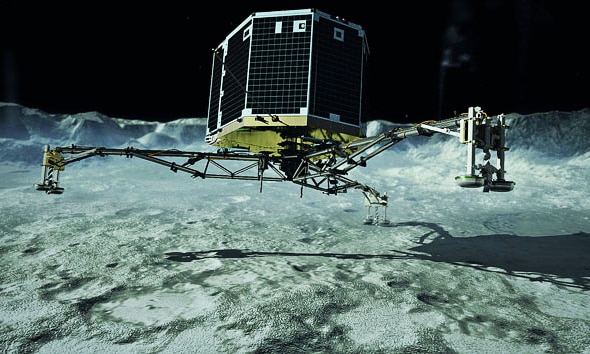Create a free profile to get unlimited access to exclusive videos, sweepstakes, and more!
A Long, Cold Sleep for Philae

Sadly, it looks like this is the end for Philae. The robot lander sits on the surface of the comet 67/P Churyumov-Gerasimenko, and no contact has been made with it for more than half a year. Despite some hope that conditions might improve for it, scientists and engineers with the European Space Agency have all but declared it dead.
In November 2014, Philae made history with the first time humans ever attempted to send a probe down to a soft-landing on surface of a comet. It was a very exciting time, fraught with nail-biting moments. The plan was for the lander to drop down to the comet, and when it made contact, a cold-gas system on its back would blast a jet to hold it down on the surface while harpoons would fire to anchor it there.
But that’s where things went wrong. Neither the gas jet nor the harpoons deployed successfully. Not only that, the surface was far harder than expected (it was thought the surface should be fluffy). Instead of securing itself, the lander bounced. In the comet’s almost negligible gravity (a typical human would weigh a mere quarter ounce standing on the surface), the impact and bounce sent the lander flying back into space. It arced a kilometer or so off the surface before the meager gravity pulled it back down. It bounced again, and finally settled onto the comet a long way from the target, in terra (cometa?) incognita.
It’s still not known exactly where Philae landed. But communication from it was received by Rosetta and sent back to Earth, showing truly amazing close-up shots of the comet’s surface. Philae apparently fell on its side and could see a steep cliff above it. But there wasn’t enough information to pinpoint its location.
Worse, it wasn’t getting enough sunlight to its solar panels to recharge its battery. Engineers commanded it to rotate a bit, and that helped. But only a little; eventually power dropped and the lander went into hibernation. It was hoped that the comet’s rotation would give it enough exposure to sunlight over time to recharge the battery enough that it would switch back on … and it did! In June 2015 the lander sent a signal to Rosetta once again.
But that was short-lived, and Philae once again fell silent, despite several attempts to communicate with it. The Rosetta probe itself couldn’t approach the comet too closely to increase the odds, either. The whole point of the mission was to observe a comet in situ as it approached the Sun, got warmed by sunlight, and became more active as ice turned into gas, blowing away from the surface. That part of the mission has been magnificent, but the increased activity made it impossible for Rosetta to get too close.
Still, the activity slowed for a while, and engineers commanded the probe to move in. However, once again, attempts to talk to Philae were met with silence. Given conditions on the comet now, the chances of it waking back up are essentially zero. More attempts will be made—you never know—but most of the Rosetta team seems resigned to Philae’s fate.
It’s easy to anthropomorphize the scrappy robot, and feel for its woes. While I’m sad the lander’s mission is at an end, this in no way means the mission was a failure. Quite the opposite! Despite setbacks and malfunctions, it managed to land on the surface of a comet and send back high-resolution close-ups of the surface! That was a phenomenal achievement, and truly a giant leap for space exploration.
And we’re not done yet. Rosetta’s been orbiting the comet since August 2014, and the mission is due to end this autumn. In September 2016, the plan is to drop the probe ever closer to the comet, eventually landing it gently onto the surface. It’s very unlikely it will survive contact, but it will send data back to Earth as long as it possibly can. At that point it will join Philae in the long, cold sleep, orbiting the Sun forever as part of the comet it studied for so long.
I can’t think of a more fitting end to such a successful mission. It will be bittersweet, of course, but Rosetta and Philae will also forever be a part of space exploration history. May they inspire future mission planners to plan so boldly.


























